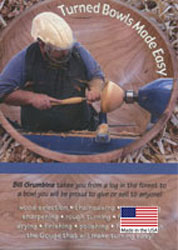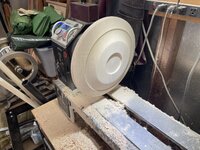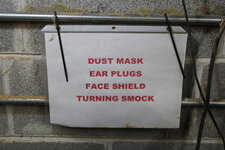Eric
The key distinction is the direction of the grain as the blank rotates. In 'spindle' turning, the grain is parallel to the axis of rotation, while in 'bowl' turning, the grain is perpendicular to that axis. The consequence of this distinction is that in 'bowl' turning, the tool can engage with the ends of the grain at two points during each rotation of the workpiece, and the concern is for what happens when that occurs.
Basically, there are two possible concerns - one is very serious, and the other is merely a nuisance. The nuisance is that as the workpiece rotates, the ends of the grain engage with the tool in a way that causes the grain to be torn. As a result, there will be two areas on the circumference of the workpiece that will be rough and require a lot of sanding. Proper tool handling goes a long way to minimizing this problem - which is to say that you get better with practice.
The other concern is that when the edge of the tool interacts with the ends of the grain (twice per revolution of the workpiece), there is an increased risk of a catch. When you get a catch, that imposes a downward force on the tip of the tool. With the tool against the toolrest, that downward force on the tip results in an upward force on the handle of the tool. So this leads to two conclusions:
1. It is helpful, when doing 'bowl' turning, to use tools with longer handles since a longer handle allows you to resist that force with less stress on your hand and arm.
2. It is safer to use tools that have more robust shanks that can more easily withstand that momentary stress.
That's the general theory. Reducing this to practice results in these guidelines:
- Take your time and avoid aggressive cuts that are more likely to cause catches.
- When initially roughing out a blank, it is easier and safer to cut from the face of the blank out to the circumference. Trying to cut straight across the circumference will always be more difficult, and will entail a greater risk of either a catch, or a shard of wood flying off the workpiece. And cutting from the face out to the circumference also minimizes grain tearing.
- Never use a tool with a narrow, weak shank. To be specific, the shank on most 'spindle roughing gouges' narrows at the point where it enters the handle, and should never be used in 'bowl' turning. If you get an end-grain catch with a spindle roughing gouge, the shank can break at the narrow point causing the tool to fly up into your face.
- A spindle gouge with a shank having a uniform cross section across its length can be used in 'bowl' turning. But a bowl gouge generally has a more robust shank compared with a spindle gouge with the same edge, and therefore is easier to use.
- Any scraper can be used provided the shank has a uniform cross section and the edge approaches the workpiece at a negative angle.
- Likewise, carbide tools also can be used in 'bowl' turning provided the shank has a uniform cross section along its entire length. However, it is prudent to tilt the cutter so that it approaches the workpiece at an angle - that will result in a smoother surface and less torn grain.
- A skew chisel is not especially useful in 'bowl' turning. Some people do use the tip of a skew to cut details on a bowl, and it is possible to use a skew as a 'negative rake scraper', but a 'planing cut' with a skew chisel won't work well on a bowl and is likely to result in a pretty dramatic catch.
- Be prepared to do more sanding than you would do for a spindle project.. And using a coarser grade of abrasive may be necessary to smooth that torn end-grain.



